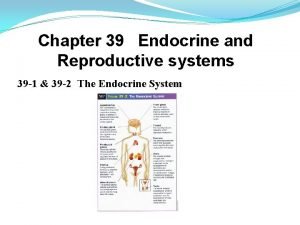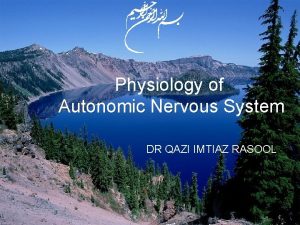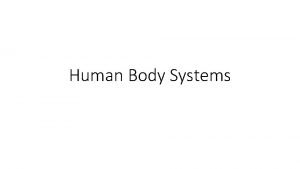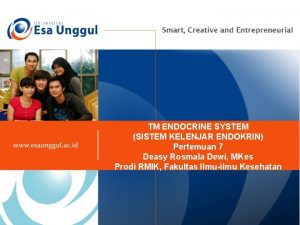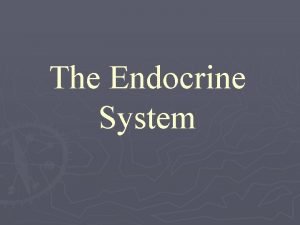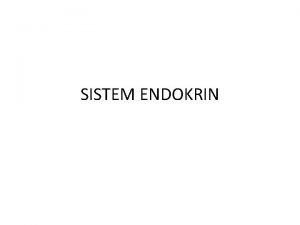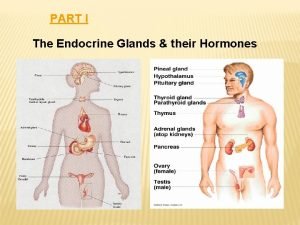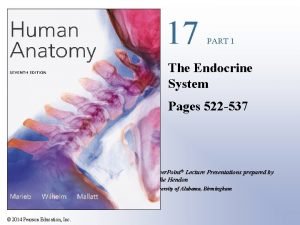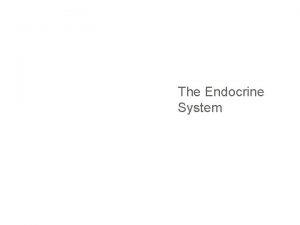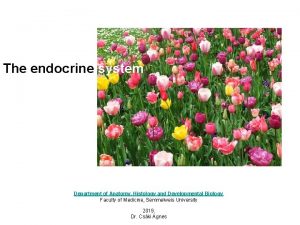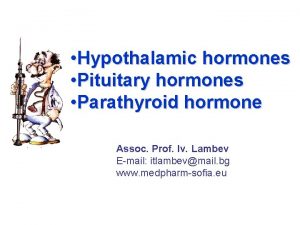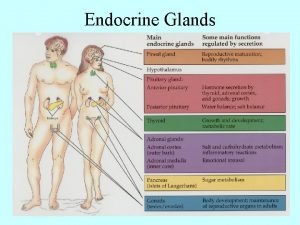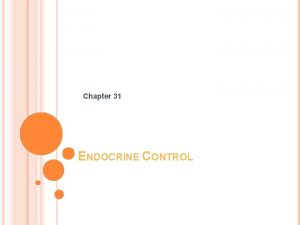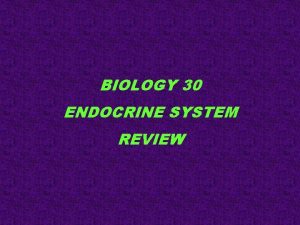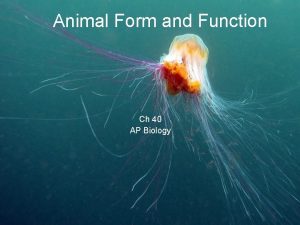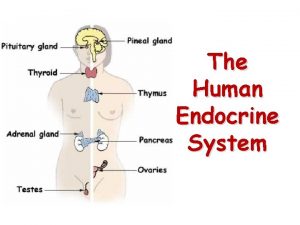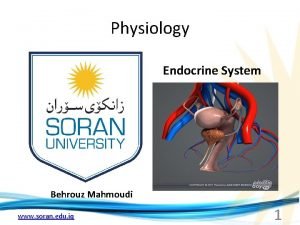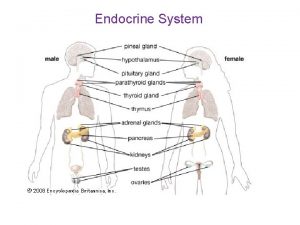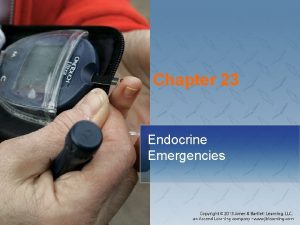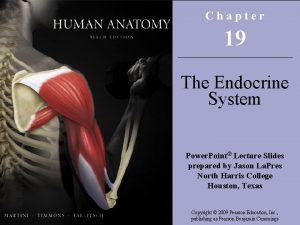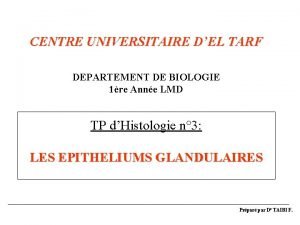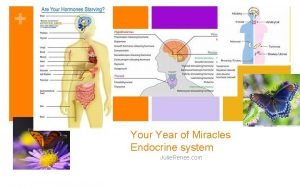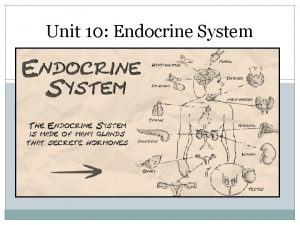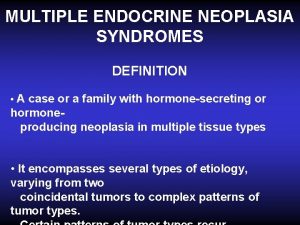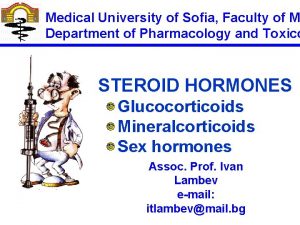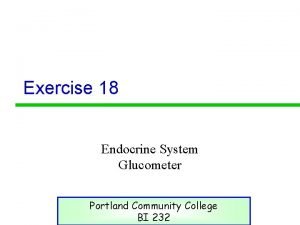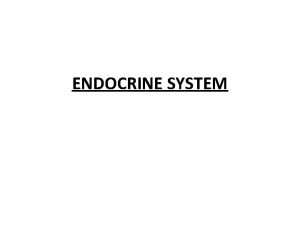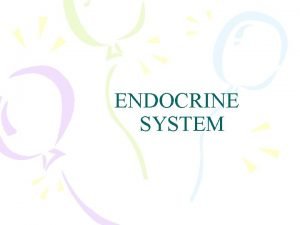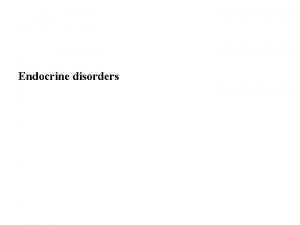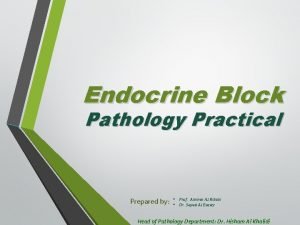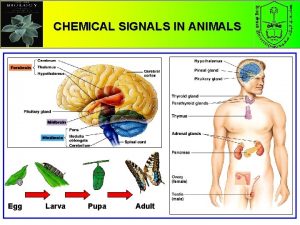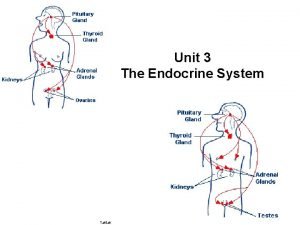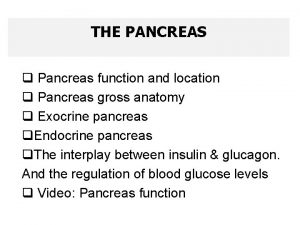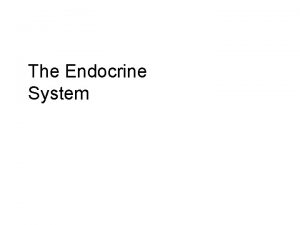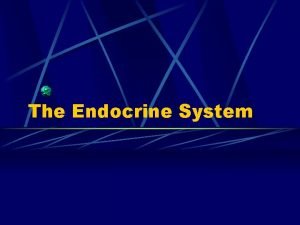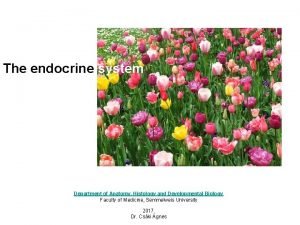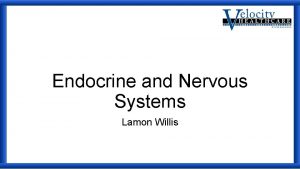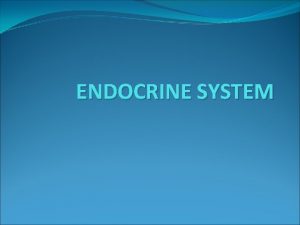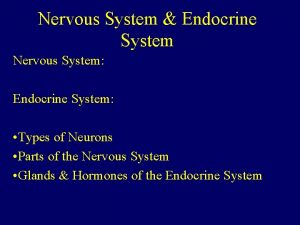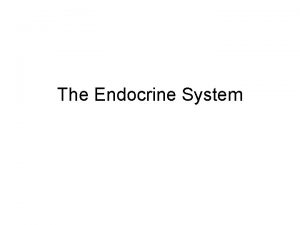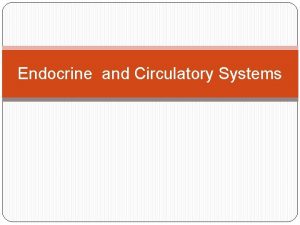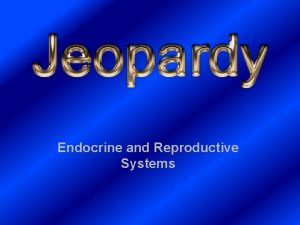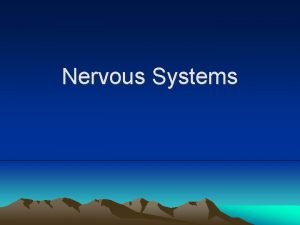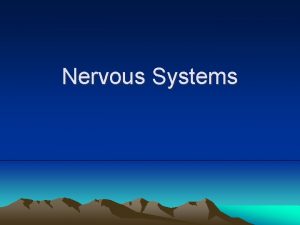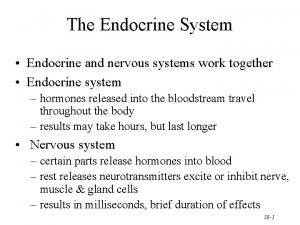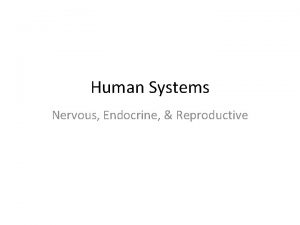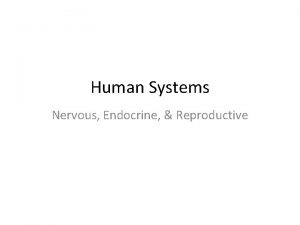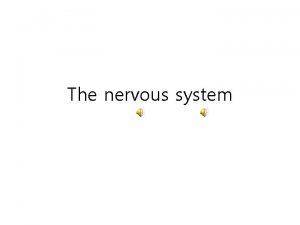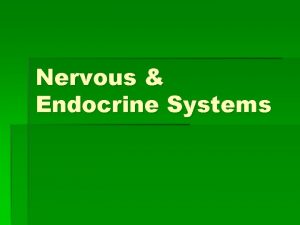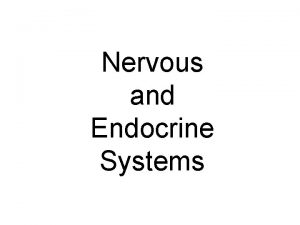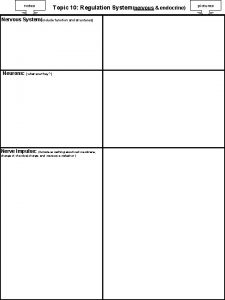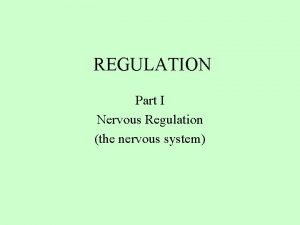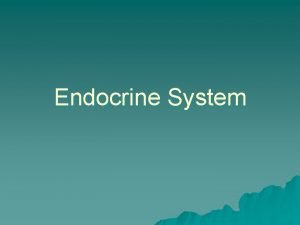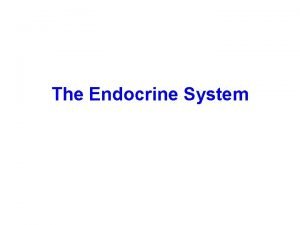Regulation Nervous Endocrine Systems Topic 15 Regulation Control











































































- Slides: 75

Regulation: Nervous & Endocrine Systems Topic 15

Regulation Control & Coordination of life functions Organisms must respond to changes in the environment to maintain homeostasis

2 Systems for Regulation: Nervous & Endocrine Work together to maintain homeostasis

Nervous Nerves, Spinal Cord & Brain Endocrine Glands

Similarities Nervous Maintains homeostasis Secrete chemicals: neurotransmitters Endocrine Maintains homeostasis Secrete chemicals: hormones

Differences Nervous Fast response Lasts a short period of time Endocrine Slow response Lasts for a long period of time

Regulation Stimulus: Change in internal or external environment Response: Action or movement

Receptor Special structures that are sensitive to specific stimuli aka SENSE ORGANS Receptors Receive!

Impulse Electrochemical charge sent along a neuron Message sent from the receptor to effector

Effector Structure which responds to the stimulus End of the impulse Effector Ends!


Stimulus identified by a Receptor → Impulse (message) → Effector which Responds

The Nervous System Topic 15 -A

The Neuron aka Nerve Cell Receives and transmits impulses

Dendrite Short branches Receive impulses→ Send toward cyton

Cyton Cell body Contains nucleus & organelles

Axon Long, thin Carries impulse away from cyton Ends in terminal branches

Myelin Sheath Fatty layer that surrounds the axon Insulates axon Speeds impulses

Synapse Space between neurons

Sensory Neuron • Carry impulses from the receptor to the brain or spinal cord Sensory Neuron

Interneuron (Associative Neuron) • Relays impulses between the sensory and motor neurons • Located in brain and spinal cord

Motor Neuron • Carry impulses from the brain and spinal cord to effectors Motor Neuron

Remember! Sensory = senses Motor = moves Inter = in between

Reflex Arc Path of an impulse Only goes to spinal cord, not all the way to brain Quick Involuntary


R→S→I→M→E Receptor → Sensory Neuron → Interneuron → Motor Neuron → Effector

Neurotransmitters • Chemical messengers • Move across the synapse • Pass impulse from one neuron to the next • The neurotransmitter must fit into the receptor site to pass the impulse (lock & key)


https: //www. youtube. com/watch? v= 7_frccg. VAWQ

Examples of Neurotransmitters • Acetylcholine • Norepinephrine • Histamine • Dopamine • Serotonin • Epinephrine


Central Nervous System Brain & Spinal Cord

Human Brain


Protected by: Cranium 3 layers of membranesmeninges

Cerebrum Largest part of brain 2 partshemispheres Controls voluntary actions Memory, learning & thought

Cerebellum Coordination of voluntary – motor activities Controls involuntary balance

Medulla Connects brain and spinal cord Controls involuntary actions- heart rate, breathing


The Spinal Cord Thick nerve Protected by: Vertebrae Meninges Spinal fluid

Peripheral Nervous System All nerves outside of the central nervous system Extends throughout the body

Somatic Nervous System Autonomic Nervous System Controls voluntary movement of skeletal muscles Controls involuntary functions Cardiac muscle, glands, and smooth muscle

Malfunctions of the Nervous System

Meningitis Inflammation of the meninges around brain & spinal cord Viral or bacterial infection Can lead to hospitalization

Cerebral Palsy Form of paralysis Congenitalpresent from birth Causes involuntary movement of the voluntary muscles

Stroke Caused by blood clot or cerebral hemorrhage (bleeding in brain) Can result in brain damage or paralysis

Polio Virus Damages nerve cells in spinal cord, arms and legs Crippling The polio vaccine has almost eradicated (completely eliminated) the polio virus Sabin-Salk Vaccine

Endocrine System Topic 15 -B

Endocrine System • Made of glands, located throughout the body • Regulates metabolism, growth and reproduction

Glands 2 Types • Exocrine- have ducts which carry secretions Sweat glands, sebaceous glands, digestive glands • Endocrine- ductless, release secretions into bloodstream

Endocrine Glands • Secrete hormoneschemical messengers • Specific- only affect target tissues

Hormones Remember they are SPECIFIC! A hormone will only work on the target tissue It fits into a specific receptor on the surface of the cell membrane. LOCK & KEY

Regulation of Hormone Secretion Hormones are only secreted when needed by the body. This is known as FEEDBACK

Positive Feedback Reinforces original change Creates a greater change Example: When Oxytocin is produced it cause uterine contractions to increase during childbirth.

Negative Feedback Opposite of original change Most common form of feedback Example: TSH causes the thyroid to produce thyroxin, when thyroxin level is too high causes TSH levels to decrease, Thyroxin level lowers

Pituitary Gland “Master Gland” Secretes hormones that stimulate other glands

Pituitary Hormones Thyroid stimulating hormone (TSH)- stimulates the thyroid to secrete thyroxin Follicle stimulating hormone (FSH)stimulates ovaries & testes Growth Hormone (GH)- increases growth of bones & muscles Leutinizing Hormone (LH)- stimulates ovulation in females

Thyroid Located in the neck, on the sides of the trachea Hormone: Thyroxin Contains iodine Regulates metabolism Needed for normal growth & development

Parathyroid Located within the thyroid gland Hormone: Parathormone Controls metabolism of calcium in the body

Adrenal Gland 2 glands Located on top of the kidneys Hormones: Epinephrine (Adrenaline) Emergency situations Increases heart rate, respiration & blood sugar levels “Adrenaline Rush” Cortisol- Regulates metabolism of sugar

Islets of Langerhans Group of cells located in the pancreas Hormones: Insulin Needed to allow glucose into cells Lowers blood sugar levels Produced after we eat Glucagon- Increases blood sugar levels Releases glucose from liver when sugar levels are low

Gonads- Sex Glands Sex cells mature Become eggs in females and sperm in males

Testes Location: in scrotum Hormone: Testosterone Develops secondary sex characteristics Deep voice, facial hair

Ovaries Location: Lower abdomen Hormones: Estrogen- Develops secondary sex characteristics Broader hips, hair growth Regulates menstrual cycle Progesterone- Regulates menstrual cycle

Hypothalamus Connects the nervous and endocrine systems Stimulates the Pituitary Gland Stimulate=Start

Malfunctions of the Human Endocrine System Hypersecretion: too much of a hormone is released Hyposecretion: too little of a hormone is released Need just the right amount to maintain HOMEOSTASIS!

Goiter Enlargement of thyroid gland Caused by hyposecretion of thyroxin and iodine deficiency

Diabetes Insulin deficiency Causes blood sugar level to be too high Treated with medication and diet

Acromegaly Too much growth hormone produced AFTER skeleton & organs finish growing Causes enlargement of body tissues

Dwarfism Some forms are genetic while others are caused by deficiencies in growth hormones

Chemical Control in Plants Hormones allow for: Growth Reproduction TROPISMS- response to stimulus Ex: Phototropism- response to light Hydrotropism- response to water Occurs in roots, stems & seeds

Role of Hormones Auxin A hormone that allows for cell division & growth Unequal amounts of auxin causes tropism


Images: • • • • • http: //www. health. com/health/static/hw/media/medical/hw/ h 9991474_001. jpg • Biology: The Study of Life, Prentice Hall 1991 http: //alteredstates. net/barry/newsletter 449/Neurotransmitters. jpg • http: //www. humanillnesses. com/original/images/hdc_0001_0 • 001_0_img 0080. jpg http: //www. umsl. edu/~keelr/pics/neural. jpg • NYS Regents Exams- Living Environment & Biology http: //www. joelertola. com/tutorials/brain/gifs/Brain. gif • http: //scienceblogs. com/pharyngula/2008/10/20/brain. jpg http: //www. morphonix. com/software/education/science/brai • n/game/specimens/images/wet_brain. gif • http: //www. simpsonstrivia. com. ar/simpsonsphotos/wallpapers/homer-simpson-wallpaper-brain-1024. jpg http: //avm. ucsf. edu/patient_info/What. Is. An. AVM/images/imag • e 015. gif http: //www. cancer. duke. edu/btc/uploads/img 439 dc 01114358. • gif http: //www. duiattorneydirectory. com/DUI-attorney-brain. gif http: //www. umm. edu/graphics/images/en/18008. jpg http: //www. nlm. nih. gov/medlineplus/ency/images/ency/fullsi ze/19236. jpg http: //nursingcrib. com/wp-content/uploads/brainmembrane. jpg http: //academic. kellogg. edu/herbrandsonc/bio 201_mckinley/f 15 -17_hypothalamus_c. jpg http: //apbrwww 5. apsu. edu/thompsonj/Anatomy%20&%20 Phy siology/2010%20 Exam%20 Reviews/Exam%204%20 Review/ thalamus-hypothalamus. jpg http: //www. brainexplorer. org/brain-images/pons 2. jpg http: //www. cedars-sinai. edu/Patients/Programs-and. Services/Spine-Center/Anatomy-of-the. Spine/Images/468380_SPINALCO_copy. jpg http: //www. scirecovery. org/images/vertebraeandspinalcord. jpg http: //www. nlm. nih. gov/medlineplus/ency/images/ency/fullsi ze/19619. jpg http: //sifoundation. webs. com/spinal_cord. jpg http: //www. passenlaw. com/blog/wpcontent/uploads/2010/03/cerebral-palsy-types. gif http: //www. nlm. nih. gov/medlineplus/ency/images/ency/fullsi ze/17133. jpg http: //www. famous-scientists. net/images/jonas-salk. jpg

http: //www. emcom. ca/images/body. jpg http: //nutritiondoctordirect. com/images/endo. gif http: //www. umm. edu/graphics/images/en/19239. jpg http: //tuberose. com/Graphics/thyroid-gland. jpg http: //emadoctors. com/images/pic 1. jpg http: //www. nlm. nih. gov/medlineplus/ency/images/ency/fullsize/8720. jpg http: //www. pre-diabetes. com/images/medical/adam-pancrease. jpg http: //www. visualphotos. com/photo/1 x 8468099/woman_with_goiter_4 k 4361. jpg http: //www. eurodieet. eu/workfiles/image/colloid_goiter_2_080613. jpg http: //files. mda 06 hs. webnode. com/200000007 -cb 158 cc 0 ef/uchr_01_img 0062. jpg http: //content 9. flixster. com/photo/11/27/46/11274639_gal. jpg https: //s 10. lite. msu. edu/res/msu/botonl/b_online/library/cat/tropism. gif http: //163. 16. 28. 248/bio/activelearner/36/images/ch 36 c 2. jpg
 Module 10 the nervous and endocrine systems
Module 10 the nervous and endocrine systems Endocrine system and nervous system
Endocrine system and nervous system Comparison of endocrine and nervous system
Comparison of endocrine and nervous system Endocrine and nervous system comparison
Endocrine and nervous system comparison Nervous system vs endocrine system venn diagram
Nervous system vs endocrine system venn diagram Endocrine system
Endocrine system Label the different types of neuronal pools in the figure.
Label the different types of neuronal pools in the figure. Sensory input and motor output
Sensory input and motor output Processes of neuron
Processes of neuron Nervous mechanism for regulation of blood pressure
Nervous mechanism for regulation of blood pressure Chapter 39 endocrine and reproductive systems
Chapter 39 endocrine and reproductive systems Portal circulation
Portal circulation Concluding sentence
Concluding sentence Narrowing down a topic exercises
Narrowing down a topic exercises Chapter 14 lesson 3 the nervous system
Chapter 14 lesson 3 the nervous system Prevertebral ganglia
Prevertebral ganglia Chart of nervous system
Chart of nervous system Nervous interactions with other systems
Nervous interactions with other systems Module 10 topic 1 vehicle warning systems
Module 10 topic 1 vehicle warning systems Topic 2 free enterprise and other economic systems
Topic 2 free enterprise and other economic systems Tabel kelenjar endokrin dan hormon yang dihasilkan
Tabel kelenjar endokrin dan hormon yang dihasilkan Major endocrine glands male and female
Major endocrine glands male and female Chapter 16
Chapter 16 Endocrine system and reproductive system
Endocrine system and reproductive system Kelenjar endokrin
Kelenjar endokrin Parts of the endocrine system
Parts of the endocrine system Endocrine anatomy
Endocrine anatomy Endocrine molecules
Endocrine molecules Facts about the endocrine system
Facts about the endocrine system Difference between endocrine and exocrine glands
Difference between endocrine and exocrine glands Lymphatic system vs endocrine system
Lymphatic system vs endocrine system Endocrine system of rat
Endocrine system of rat Chapter 46 digestive and endocrine disorders
Chapter 46 digestive and endocrine disorders Chapter 45 hormones and the endocrine system
Chapter 45 hormones and the endocrine system Chapter 29 endocrine and metabolic disorders
Chapter 29 endocrine and metabolic disorders Chapter 19 endocrine and hematologic emergencies
Chapter 19 endocrine and hematologic emergencies Humoral neural and hormonal stimuli
Humoral neural and hormonal stimuli 7:13 endocrine system
7:13 endocrine system Stimulus endocrine system
Stimulus endocrine system Fungiform papillae histology
Fungiform papillae histology Humoral stimulus
Humoral stimulus Endocrine histology
Endocrine histology Endocrine axis
Endocrine axis Colloid anatomy
Colloid anatomy Endocrine exocrine
Endocrine exocrine Histology thyroid gland
Histology thyroid gland Whats the difference between endocrine and exocrine glands
Whats the difference between endocrine and exocrine glands Chapter 11 endocrine system
Chapter 11 endocrine system Biology 30 endocrine system
Biology 30 endocrine system Ap biology chapter 40
Ap biology chapter 40 Estrogen effect
Estrogen effect Endocrine
Endocrine Thymic carcinoma
Thymic carcinoma Endocrine glands
Endocrine glands Endocrine system function
Endocrine system function Chapter 23 the endocrine system
Chapter 23 the endocrine system Pearson endocrine system
Pearson endocrine system Glande endocrine exocrine
Glande endocrine exocrine Your year of miracles
Your year of miracles Endocrine system analogy
Endocrine system analogy Multiple endocrine neoplasia type 2
Multiple endocrine neoplasia type 2 Endocrine axes
Endocrine axes Endocrine organs
Endocrine organs Introduction of endocrine system
Introduction of endocrine system Classification of hormones
Classification of hormones Exocrine glands function
Exocrine glands function Goitre
Goitre Papillary thyroid carcinoma gross
Papillary thyroid carcinoma gross Endocrine weight loss
Endocrine weight loss What are chemical signals
What are chemical signals T3.taktak
T3.taktak Location of pancrease
Location of pancrease Endocrine glands
Endocrine glands Endocrine glands
Endocrine glands Endocrine vs exocrine
Endocrine vs exocrine Endocrine organ histology
Endocrine organ histology










